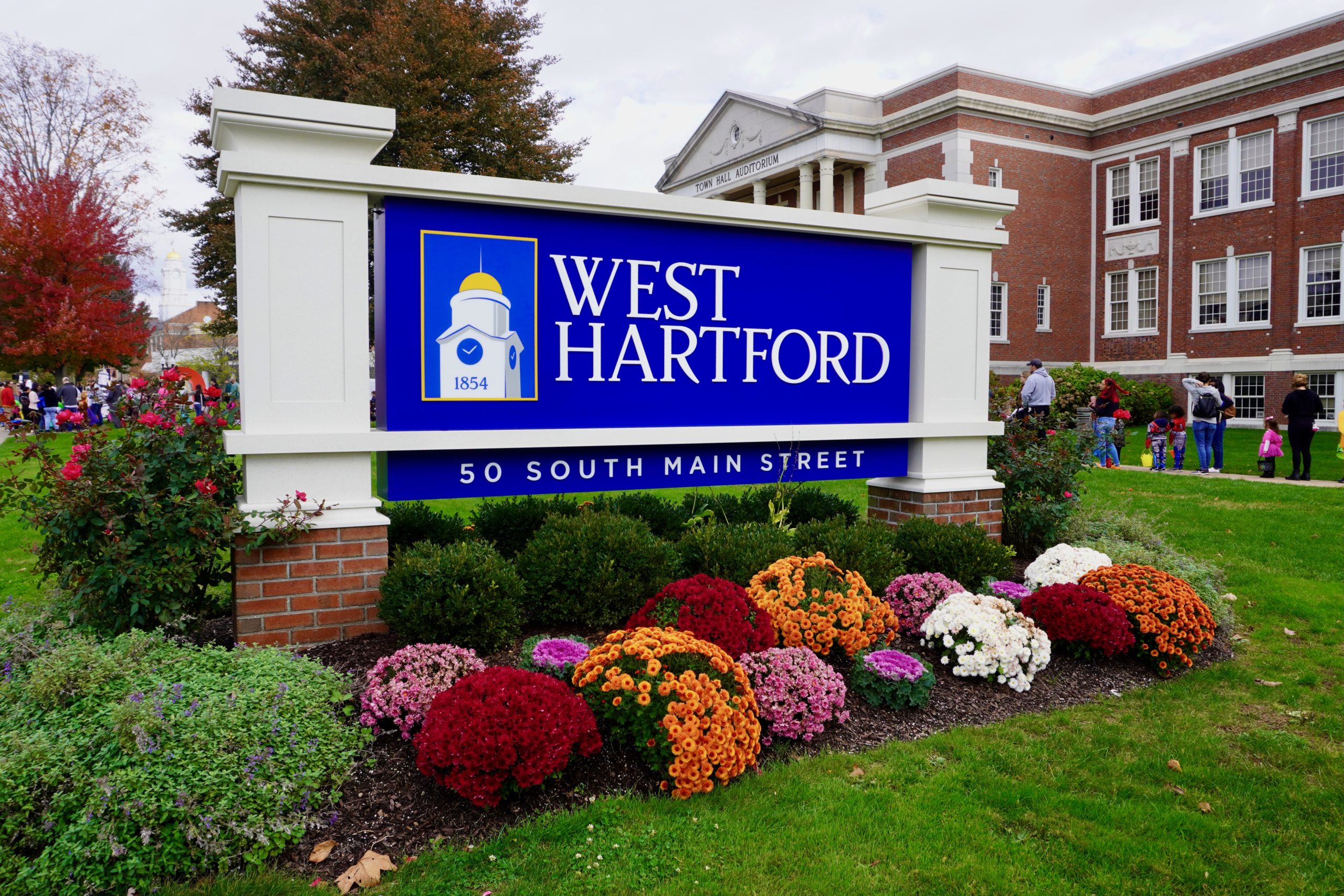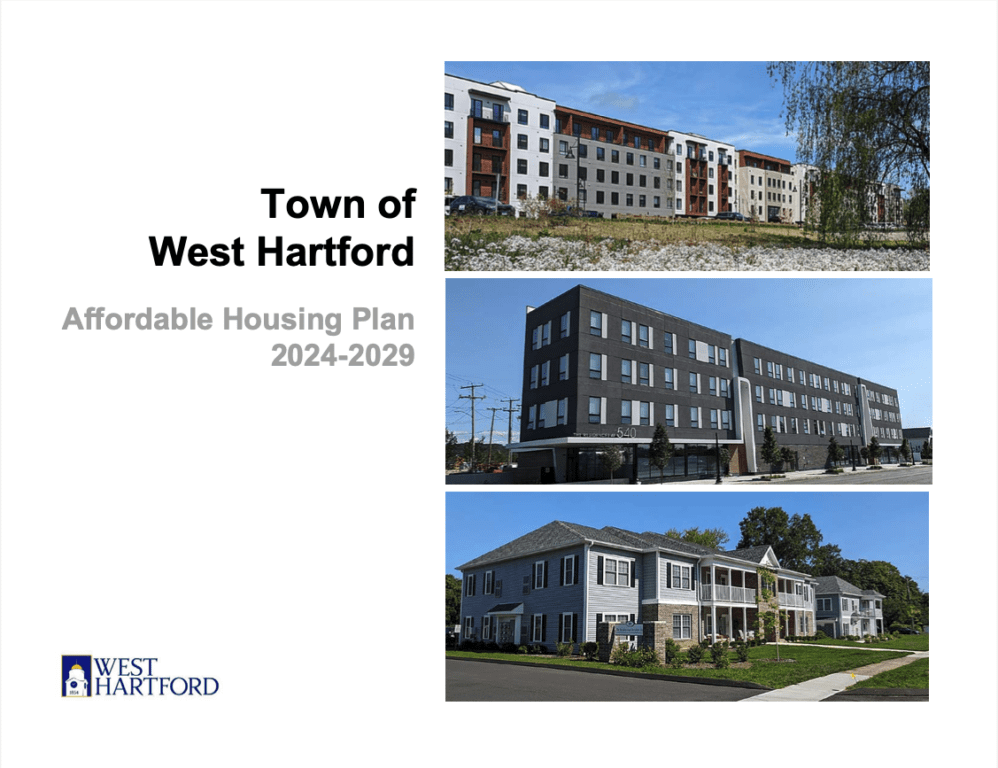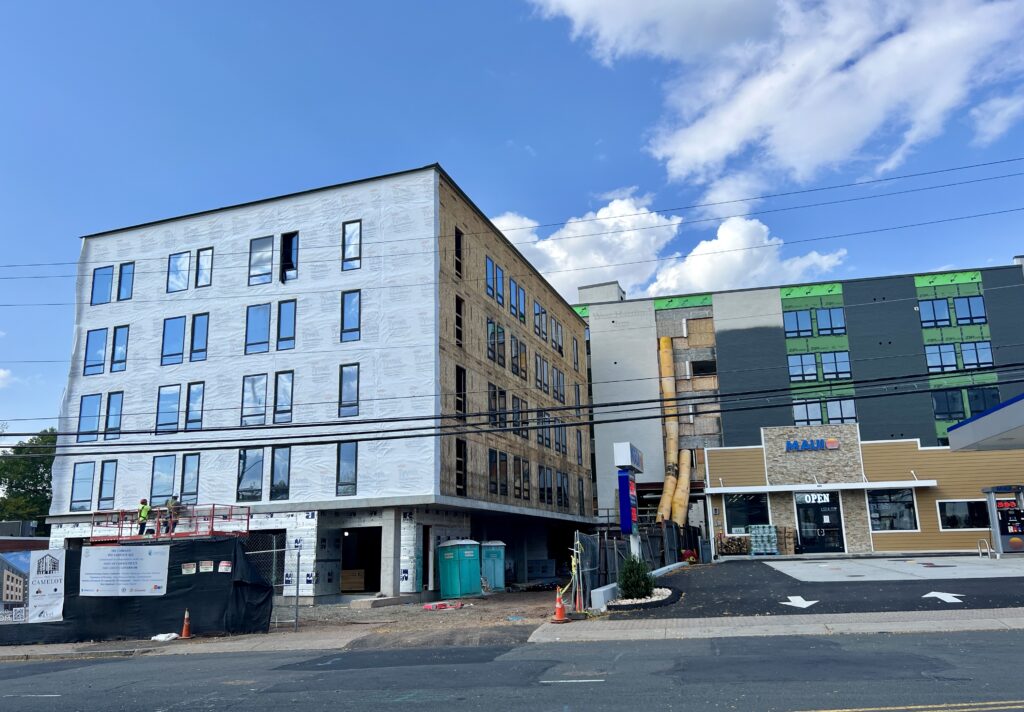West Hartford Town Council Adopts Affordable Housing Plan

Audio By Carbonatix

West Hartford Town Hall. Photo credit: Ronni Newton
By an 8-1 vote, the West Hartford Town Council officially adopted its 2024-2025 Affordable Housing Plan Tuesday night.
By Ronni Newton
The Town of West Hartford, like all Connecticut municipalities, is required by state statute to create and adopt an affordable housing plan every five years, and after a lengthy process that involved Town Planner Todd Dumais and other town staff, contributions of an advisory group and consultant Goman + York, results of a town-wide survey that had more than 1,400 responses, and the input of the Community Planning and Economic Development (CPED) Committee which reviewed the plan at four meetings, the final product was brought to the Town Council for adoption at its Oct. 8, 2024 meeting.
Town Manager Rick Ledwith summarized and outlined the sections of the Affordable Housing Plan – which was previously approved by the Town Plan and Zoning Commission and found consistent with the existing Plan of Conservation and Development (POCD) – before Council members voted to adopt it, 8-1, with Republican Mary Fay casting the vote against the plan.
Ledwith said Tuesday that “it didn’t take a state statute for us to address affordable housing. This Town Council has been focused on affordable housing long before this state statute became effective.” Examples he cited include the Plan of Conservation and Development for 2020-2030, as well as the use of $6 million of the town’s American Rescue Plan Act (ARPA) funds for establishment of an affordable housing development program.
The plan identifies existing housing needs, and “identifies both opportunities and challenges” involved with creating more affordable housing, Ledwith said as he outlined the structure of the 2024-2029 Affordable Housing Plan, a full copy of which can be found online and is also provided as a PDF below.

Screenshot of cover of West Hartford Affordable Housing Plan
Four in-depth sections of the plan, Ledwith said, include an introduction that highlights the affordability crisis nationwide. The second section is a description of the plan, that dives into “what is affordable housing” noting that housing is “unaffordable if a family spends more than 30% of their income on housing costs.” West Hartford currently has 7.65% of its current housing stock deemed affordable, but that does not include several of the large developments on that are under construction – which will ultimately add 522 affordable units and bring the town’s percentage to 9%, “a number we should be very proud of,” Ledwith said.
While state statute identifies a minimum threshold of 10% affordable housing as a goal, Ledwith said, “Our plan is not only to get to that 10% over time, but to get over that number.”
The third section of the plan provides an overview of existing conditions in West Hartford, including demographics and socioeconomics as well as an analysis of the current housing stock indicating that the vacancy rate is 1.3% for owner-occupied units and 4.4% for rentals. “Anything below 5% indicates a very strong market and signals a need for additional supply,” Ledwith said.
The Affordable Housing Plan’s final section outlines strategies to increase affordable housing options, highlighting many of the actions the Town Council has already taken, Ledwith said, including the 522 new affordable housing units approved over the past few years, some of which are already built, others under construction, and those approved and awaiting construction. Conversations with developers now always include affordable housing, he said.
The $6 million Affordable Housing Development Fund is highlighted as “one of the most visionary and unique uses of ARPA funds to encourage the development of new affordable housing in the state of Connecticut and something the Town Council should be incredibly proud of,” Ledwith said. Other strategies cited in the plan, that could be used to encourage additional affordable housing, if the Town Council chooses to implement them, include are tax abatements, reduction in building permit fees, inclusionary zoning, exploring tax increment financing districts, housing trust funds, use of town-owned land, and expanding the use of the Community Development Block Grant (CDBG) Homeowner Rehabilitation Program.
“The adoption of this plan will be a significant step forward in our commitment to fostering a more inclusive and sustainable community and will provide a foundation for future housing policies and initiatives,” Ledwith said.

The Camelot, which will provide 44 units of affordable housing, is under construction at 900 Farmington Avenue. Photo credit: Ronni Newton
Members of the Town Council shared some comments before voting.
Democrat Tiffani McGinnis, who chairs the CPED Committee, voiced her support for the plan and said West Hartford has been a leader, encouraging the creation of housing that she personally would have qualified for when she was in her 20s and 30s. “This document is not the end of what we are going to do. It is the beginning … communities need people from all socioeconomic levels and it’s important to help make that possible,” she said.
Democrat Deb Polun also noted support for the plan “not only as report of our past work but as a guide for our future.” Making housing available matters, and “making housing available is arguably the most impactful action we can take to promote a high quality of life for people of all ages. … It literally can change lives,” she said, and enriches West Hartford by allowing people to remain in town and bringing in new neighbors.
Councilor Carol Blanks, also a Democrat, said West Hartford has always been known as a desirable and safe community, “metropolitan with a hometown feel.” She said affordable housing is critical for people who are aging and looking to downside, as well as for young people, who like her daughters are looking for someplace that’s safe and desirable.
This plan, “also allows us to be a leader for other towns, other cities in the state that are always looking at West Hartford and what we’re doing,” Blanks said, commending all who put this forward-thinking plan together.
Republican Alberto Cortes said he reviewed the plan from the perspective of someone who lived in government housing and moved at least a dozen times in his childhood, and in his current role as a realtor and member of the Fellowship Housing Board. “Having an affordable housing plan … is extremely important,” and it’s about high quality housing for seniors, for the disabled. “We don’t do enough,” he said, noting that 80% AMI includes many young professionals. “We don’t have to love everything in the plan, and I don’t love everything in the plan here … but just having a plan and being able to look at it five years down the road.”
Republican Mary Fay said she has some concerns, which she has voiced in previous meetings where affordable housing has been discussed. “I don’t like unfunded mandates put upon us by the state and this is just yet another one,” she said, adding that at 9% we are very close to the goal threshold. “I think a lot of things in this plan hurt existing taxpayers,” she said, and although there has been lots of development in town, she said there has not been property tax relief for existing residents.
While there is a housing crisis, Fay said, she doesn’t feel this plan addresses the drivers of the lack of affordability. “I think there’s other things we can do to address it from a more holistic value,” she said, and said a lot will happen organically. Some of the strategies to continue to encourage more affordable housing concern her, Fay said. “Tax abatements – that’s a very hard pill to swallow.” She said West Hartford is desirable and will continue to get interest from developers.
Democrat Barry Walters said “attainable” and “affordable” housing are two different things, and he is happy that the plan builds on what has already been done and that West Hartford recognizes that truly affordable housing is not attainable housing. The challenge is to make sure that what is truly affordable does not feel “like less than,” he said, and to continue to treat people with the dignity and access to quality homes.
“I think this is a great start to the future,” Walters said.
Deputy Mayor Ben Wenograd said affordable housing is an issue that is close to his heart, and while West Hartford is late submitting this plan, “it’s because we’re actually doing the work.” He said that any negative comments about this plan that end up being posted to social media will be sad, because he is convinced that most residents are supportive of what is being done here to provide homes for teachers, for public staff, for kids who want to live in town, for old and new neighbors.
Wenograd said what he wanted to say really was already in the report – which he strongly encouraged people to read before posting about it on Facebook – and he read aloud a passage from the introduction (see page 4): “Planning for affordable housing is foundational to maintaining a vibrant and prosperous community. Without affordable housing, West Hartford places its desirability, vibrancy, and prosperity at risk. If West Hartford becomes too wealthy, too exclusionary, and unaffordable to working- and middle-class households, it runs the risk of being unable to retain and attract residents, businesses, and a qualified workforce.”
Mayor Shari Cantor said housing in general is a topic that drives so much and defines so much about the West Hartford community, particularly because property taxes drive so much of the town’s budget. “Housing of all kinds is a concern. … We don’t have enough inventory of homes, period.”
Property tax on a moderate home is a third of the housing cost, and “affordability is a problem,” she said. While looking to grow the grand list is one way to help by growing the tax base, “it’s also that intentional investment in options that are provided at all different income levels. … It’s an intentional effort and this does not happen by accident.”
Of the 522 new affordable units, Cantor said, “Developers don’t just build this ‘just because,'” and it requires putting a lot of pieces together. “The progress that we’ve made is being noticed, nationally actually,” as the town is adding quality affordable housing for people of all income levels, Cantor said.
“This is not complete. We are not finished,” she added. “This document, the plan, is a working document,” and some of the aspects that people may not like are just options that are part of the toolkit. Cantor noted that the tax abatement provided for One Park was to assist the development of a historic property that had been denied historic tax credits, and that had been left undeveloped for 10 years. Consultants advised the only way it would work was to provide the 10-year tax abatement, and now roughly 300 people live there and are paying taxes on their cars, and as the abatement phases out an increasing amount of revenue is coming from a formerly nontaxable property that’s also benefitting businesses along Park Road.
This plan gives the town tools to work with, Cantor said.
“This did not happen by accident,” she reiterated. Attracting developers and adding to affordable housing “takes a partnership with a municipality and lots of effort on everyone’s part.” She said she is very proud of everybody’s efforts on creating the Affordable Housing Plan.
Like what you see here? Click here to subscribe to We-Ha’s newsletter so you’ll always be in the know about what’s happening in West Hartford! Click the blue button below to become a supporter of We-Ha.com and our efforts to continue producing quality journalism.
 Loading...
Loading...




That’s great to see all this new affordable housing development spread all over town and not just concentrated in one area of town. I think the Camelot apartments will be a huge benefit to those without a car who might work in the Center or in Hartford, taking the bus, and be able to save a lot of money on gas. Also the new development on Park Rd is great because it’s now more money on the tax rolls to help alleviate homeowners in town. I’m not sure what Mary Fay is actually for though because it seems as though she’s against anything to help keep property taxes from increasing and affordable housing. She says “”I think there’s other things we can do to address it from a more holistic value,” she said, and said a lot will happen organically”. Well what are your suggestions because it doesn’t seem she has any to give and at least the rest of the town council members are trying to come up with solutions. I hope to see some of her suggestions or ideas around affordability besides letting things happen organically…whatever that means.